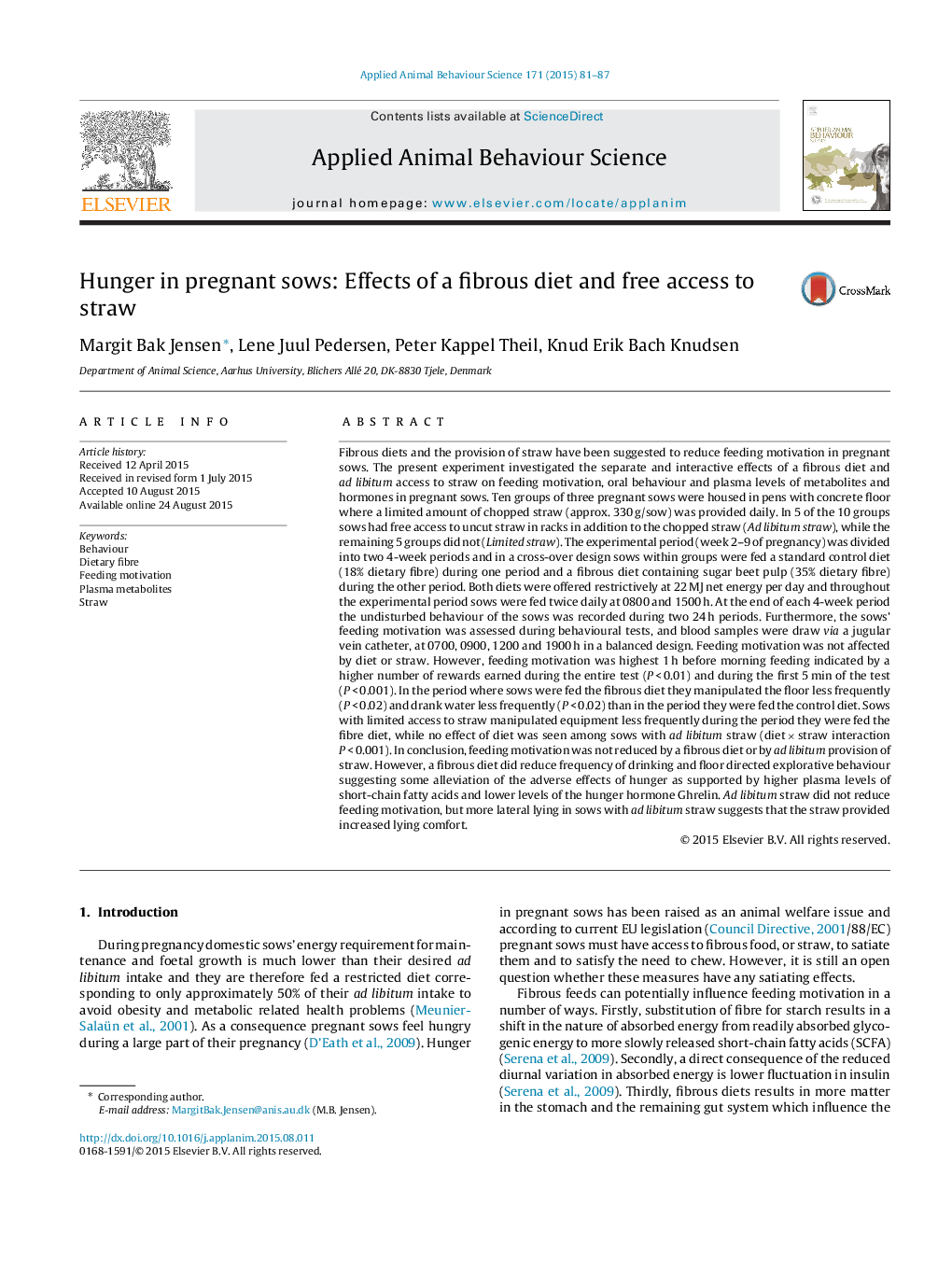| کد مقاله | کد نشریه | سال انتشار | مقاله انگلیسی | نسخه تمام متن |
|---|---|---|---|---|
| 6379470 | 1625335 | 2015 | 7 صفحه PDF | دانلود رایگان |
- We studied effects of straw and fibre diet on behavioural and physiological indices of hunger.
- Feeding motivation was highest 1Â h before morning feeding.
- Feeding motivation was not reduced by fibrous food.
- Drinking and manipulation of the floor was reduced by fibrous food.
- Plasma SCFA was increased and the hunger hormone Ghrelin was reduced by fibrous food.
Fibrous diets and the provision of straw have been suggested to reduce feeding motivation in pregnant sows. The present experiment investigated the separate and interactive effects of a fibrous diet and ad libitum access to straw on feeding motivation, oral behaviour and plasma levels of metabolites and hormones in pregnant sows. Ten groups of three pregnant sows were housed in pens with concrete floor where a limited amount of chopped straw (approx. 330 g/sow) was provided daily. In 5 of the 10 groups sows had free access to uncut straw in racks in addition to the chopped straw (Ad libitum straw), while the remaining 5 groups did not (Limited straw). The experimental period (week 2-9 of pregnancy) was divided into two 4-week periods and in a cross-over design sows within groups were fed a standard control diet (18% dietary fibre) during one period and a fibrous diet containing sugar beet pulp (35% dietary fibre) during the other period. Both diets were offered restrictively at 22 MJ net energy per day and throughout the experimental period sows were fed twice daily at 0800 and 1500 h. At the end of each 4-week period the undisturbed behaviour of the sows was recorded during two 24 h periods. Furthermore, the sows' feeding motivation was assessed during behavioural tests, and blood samples were draw via a jugular vein catheter, at 0700, 0900, 1200 and 1900 h in a balanced design. Feeding motivation was not affected by diet or straw. However, feeding motivation was highest 1 h before morning feeding indicated by a higher number of rewards earned during the entire test (P < 0.01) and during the first 5 min of the test (P < 0.001). In the period where sows were fed the fibrous diet they manipulated the floor less frequently (P < 0.02) and drank water less frequently (P < 0.02) than in the period they were fed the control diet. Sows with limited access to straw manipulated equipment less frequently during the period they were fed the fibre diet, while no effect of diet was seen among sows with ad libitum straw (diet Ã straw interaction P < 0.001). In conclusion, feeding motivation was not reduced by a fibrous diet or by ad libitum provision of straw. However, a fibrous diet did reduce frequency of drinking and floor directed explorative behaviour suggesting some alleviation of the adverse effects of hunger as supported by higher plasma levels of short-chain fatty acids and lower levels of the hunger hormone Ghrelin. Ad libitum straw did not reduce feeding motivation, but more lateral lying in sows with ad libitum straw suggests that the straw provided increased lying comfort.
Journal: Applied Animal Behaviour Science - Volume 171, October 2015, Pages 81-87
